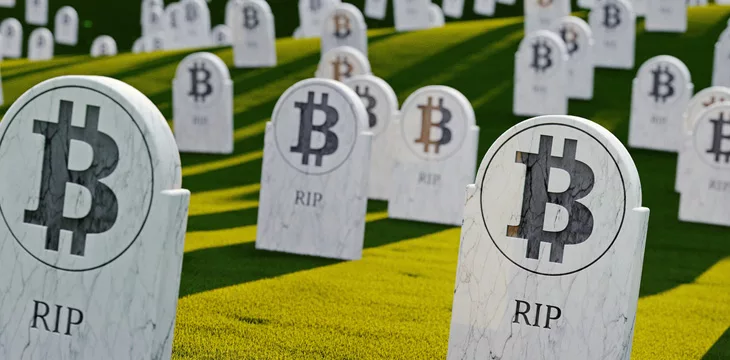|
Getting your Trinity Audio player ready...
|
2024 is officially the year of the memecoin, with even the scion of the likely next president of the United States (allegedly) getting in on the utility-light/grifting-heavy action.
On June 25, digital asset researcher Colin Wu, aka WuBlockchain, issued a report detailing the insane profitability that memecoins have enjoyed this year compared to all other ‘crypto’ sectors. Wu sums up the overall market’s current mindset as “value investing is empty, go all-in on MEME to live in the palace,” which is about as savage an indictment of this whole rotten, corrupt space as you can get.
Those interested in Wu’s methodology will find a full explanation in his report, but we’ll focus on his conclusions, which found that the average price return of the top 10 memecoins over the first half of 2024 was an astonishing 1,834%. Within this category, the highest average return was an even more ridiculous 2,405%, while a single token (BRETT) rose 14,353% from its issuance price.
By comparison, the tokenization of real-world assets (RWA) produced an average price return of ‘only’ 213.5%, making it 8.6x more profitable to speculate on memecoins. By contrast, artificial intelligence (AI) tokens improved an average of 71.5%, and the numbers just trail off further from there, with decentralized finance (DeFi) reporting a lowly 3.4% average rise. (Over the same period, major tokens such as BTC and ETH rose nearly 50% and 45%, respectively.)
Whereas memecoins were once the sole province of the Ethereum blockchain, this dominance has been usurped by rival networks such as Solana and Layer 2’s such as Base (the latter the product of the Coinbase (NASDAQ: COIN) exchange).
Things got even worse following the March launch of Pump.fun, a Solana-based memecoin generation platform. Pump allows anyone with a spare $2 to create an utterly utility-free token from scratch, leading to dozens being issued every minute, with predictable results. (Hint: swift rise, followed by an even swifter decline, after which the cycle begins anew with the next token/hype-cycle.)
Venture capitalist Andrew Kang captured this new crypto zeitgeist with a lengthy tweet in April hailing the “new class of memecoins” he called ‘Culture Coins.’ Kang defined these ‘culture’ tokens as embodying “the beliefs of real world communities that have shared values, identities, lifestyles, political views.” They still don’t actually do anything, but pray, continue with your fascinating narrative…
As stalwart examples of this brave new memecoin world, Kang singled out BODEN, which nearly hit $1 in April before rapidly sinking back to its current value of 16¢, and TRUMP, which peaked at over $17 on June 1 before swiftly shedding half that value.
Kang claimed that the strength of any given memecoin was “directly correlated to the strength of their communities,” which the above downward spirals imply are wholly occupied by lily-livered girly-men with poor decision-making abilities, but whatever.
Kang’s depiction of these ‘communities’ offers a glimpse of the new cynicism enveloping the memecoin’ sector,’ playing on group dynamics to pressure people into purchasing certain tokens and an implied threat of shunning by said ‘community’ should a regretful ‘hodler’ decide to sell out before losing everything. What are you, some kind of traitor/cuck/soyboy to sell now? A real man keeps an ironclad grip on that anvil regardless of how high the water is rising around his neck.
The only ones getting rich here
It’s not just rhetoric-heavy VCs and garden-variety scammers promoting these function-free tokens. Consider that Coinbase now relies on memecoins for well over half its transaction revenue, while fee revenue from memecoin transactions on its Layer 2 Base network hit $56 million in the first quarter of 2024.
That Base revenue figure has undoubtedly spiked even higher in Q2 as memecoin madness took hold. Over 800,000 new memecoins have been issued on Base since March, dwarfing that of any other chain. If there’s one statistic that more vividly illustrates the utter ridiculousness of ‘crypto,’ we haven’t seen it.
Meanwhile, Coinbase is still the only ‘sequencer’ (aka transaction validator) on Base, which launched in August 2023. Coinbase promised that Base would decentralize these functions’ over time,’ but you’d be hard-pressed to find any Coinbase exec offering specifics on that timeline.
Keep that self-serving mentality in mind every time you hear about the millions that Coinbase is spending on its political lobbying efforts and ask yourself just what their end game is here. There’s a finite number of real dollars in this sector and those that get out late usually get out broke. So don’t be a CHUMP.
In fact, before you visit Pump.fun, why don’t you visit our new site, Dump.misery. It works like this: you send us $2, and in exchange we agree to keep your $2. That’s it. No promises of riches, but since we get to the ‘screwed over’ portion so much faster than our rivals, we think it’s worth it.
Pharma broke
One new memecoin has made more of a public splash than all others due to its alleged ties to Barron Trump, the nine-foot-tall son of Donald and Melania Trump. TrumpCoin (DJT) made its debut about a week ago and almost immediately attracted attention due to rumors that it bore the official approval of the former (and perhaps future) president.
It started when a tech blog called Pirate Wires claimed that “per conversations,” Barron was “spearheading” the launch of DJT. The tweet was labeled a “scoop” by Michael Solana, chief marketing officer at Peter Thiel’s Founders Fund and the man behind Pirate Wires. Solana later tweeted that he “didn’t speak with trump directly … just reporting what I know via sources.”
In response to these rumors, the Arkham research firm offered a $150,000 bounty for anyone who could “definitively prove the identity of the creator” of the DJT token. The bounty was swiftly claimed by online sleuth ZachXBT, who identified the token’s creator as none other than Martin Shkreli, the ‘pharma bro’ who in 2017 was convicted of securities fraud and served several years in prison for running his pharmaceutical company “like a Ponzi scheme.”
Minutes after ZachXBT claimed the bounty, he said Shkreli “panic DM’s me” to claim that he had “1000 pieces of evidence I created [DJT] with Barron.” Around the same time, ZachXBT revealed that “one of the large DJT insiders” had dumped $832,000 worth of DJT. This insider was “coincidentally also a large holder on Martin’s other project Shoggoth.”
A half-hour later, Shkreli conducted a Twitter/X Space in which he acknowledged being the creator of DJT, while further claiming that professional misogynist Andrew Tate helped him pump the price. Shkreli insisted that he’d been approached by a classmate of Barron’s, that Barron had claimed his famous father approved of the DJT project and it was Barron himself who leaked the news to Pirate Wires.
None of Shkreli’s claims of Trump family involvement have been confirmed, nor has anyone with the Trump campaign offered any indication that they were even tangentially involved in this debacle.
While Shkreli may not have parlayed this DJT stunt into the payday he’d hoped, his involvement could have far worse implications. Specifically, Shkreli may be guilty of yet another fraud, or at least appears to have violated the conditions of his parole, which require him to stay a million miles away from “any self-employment involving access to client money or investments.”
The bottom line is this; having no purpose beyond pumping and dumping, memecoins are purpose-built for fraud. With rare exception, the only people who make money from them are those instigating and perpetuating the fraud. And if you are among the rare exceptions whose name comes up when the slot machine reels stop, remember that your gains come from someone else’s losses. It’s criminal. And you’re criminally stupid if you keep falling for this shit.
Watch: Peter Schiff sees value of Bitcoin with Tokenized Gold

 01-07-2026
01-07-2026 




